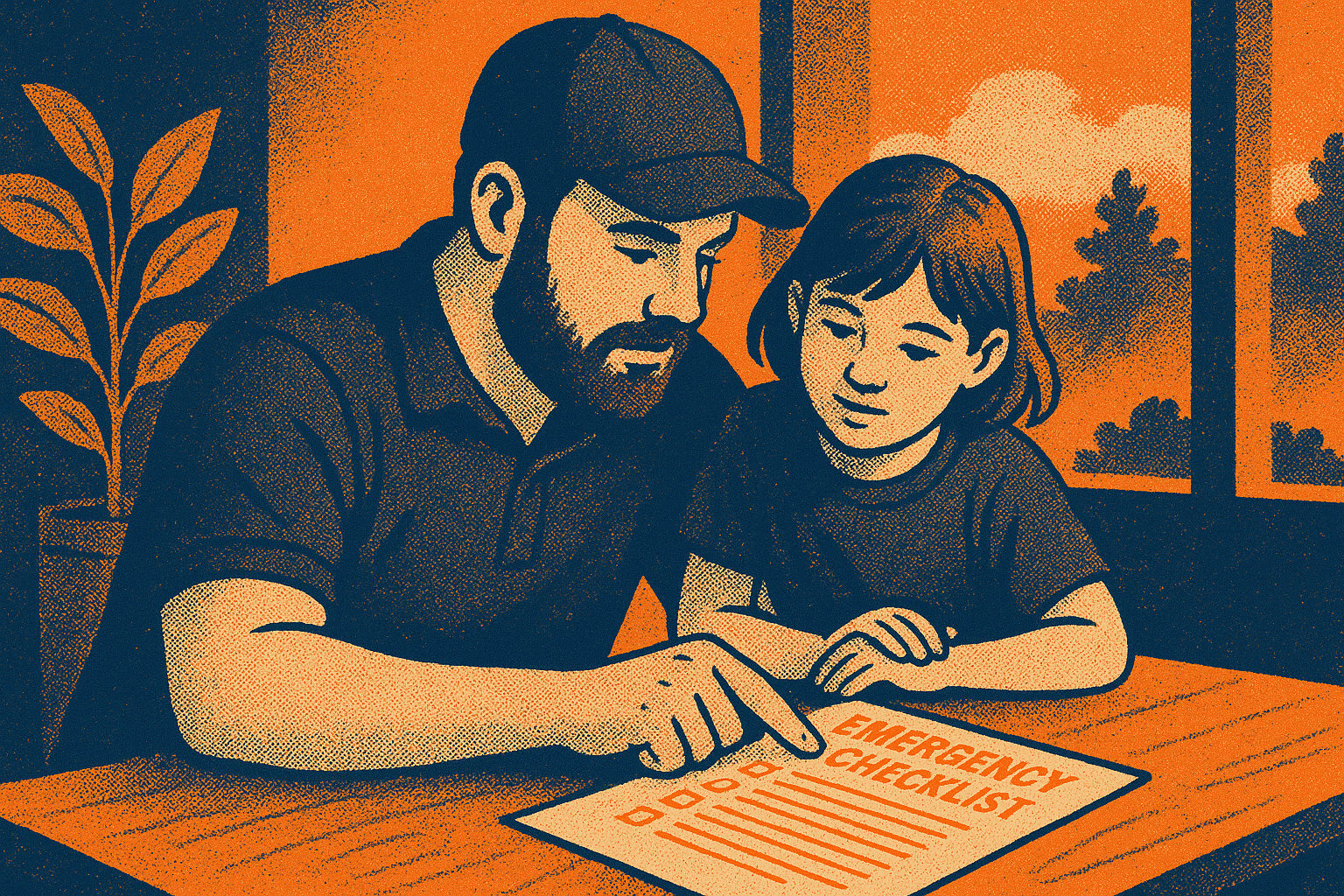Emergency Preparedness Laws: A Practical Guide for Parents and Homeowners
Written by: Bill Raymond

Emergency Preparedness Laws: A Practical Guide for Parents and Homeowners
You don't need a law degree to protect your family. This guide gives the key rules, where to check, and simple steps you can finish this afternoon. Keep the family legal checklist by your fridge.
Federal framework and the key agencies that matter to families
One-line takeaway: The federal government coordinates and funds; states and local officials run the response on the ground.
The National Response Framework explains how disasters work in the U.S.: local responders act first, states support them, and the federal government provides people, tools, and money when asked. For your family, that means local orders and local information matter most day-to-day, but a federal declaration can unlock aid.
A federal "disaster declaration" or "emergency declaration" lets FEMA and other agencies send help. Check your county on FEMA’s Disaster Declarations page. Search by state, county, or ZIP to see current and past declarations, the type (major disaster or emergency), and what programs may be available.
Quick check today:
- Look up your county on FEMA’s Declarations page and save the result.
- Note which programs are listed (for example, Individual Assistance) so you know what may apply if your home is damaged.
- Save the page in your phone’s Notes app and print one copy for your home binder.
Get the family legal checklist to capture these links and contacts on one page.
Next action: Look up your county in FEMA’s declarations database and save the page to your phone and home binder.
How state and local emergency laws typically differ (what to check in your state)
One-line takeaway: States write their own emergency powers—verify who can order what, for how long, and how it’s enforced.
Every state sets its own rules for emergencies. Common differences include:
- Who can declare (governor, mayor, county judge).
- What powers activate (curfews, evacuations, road closures, resource control).
- How long a declaration lasts and how it can be renewed.
- Penalties and enforcement for ignoring orders.
How to look up your rules:
- Use NCSL’s State Emergency Powers overview for summaries and statute links.
- Search your state code for "state of emergency," "emergency powers," and "evacuation."
- Check your county emergency management page for plans, ordinances, and alert info.
- Look up your city’s municipal code (Municode or similar) for local emergency powers and curfews.
Good starter questions for your county emergency manager:
- Who can issue an evacuation order here, and how will we be notified?
- Are there designated evacuation routes and re-entry rules for our neighborhood?
- Which shelters are ADA-accessible and family-friendly (cribs, children’s areas)?
- What local alert system should we opt into beyond phone alerts?
Get the family legal checklist to record state and county links and one contact name and phone number.
Next action: Find your state’s emergency powers page on NCSL and bookmark your county emergency management page.
Homeowner and landlord obligations: what you must know about notices, shelters, and building rules
One-line takeaway: Duties depend on local code and leases—keep egress safe, communicate clearly, and document everything.
Homeowners: Know your evacuation routes, nearest shelters, and any local building or wildfire/flood rules. Some areas require defensible space, clear addressing, or posted evacuation maps. Review your insurance policy’s notice duties (how quickly to report loss) and keep your declarations page handy.
Landlords: Duties vary by state and by lease, but typically include safe egress, access for emergency repairs, and timely notices to tenants about hazards, closures, or re-entry. OSHA’s emergency planning guidance is a useful model for clear procedures, contact lists, and incident logs you can adapt.
Simple checklist to stay compliant and organized:
- Verify exit routes are clear and lit; test smoke and CO alarms.
- Post emergency contacts in common areas and inside the lease packet.
- Maintain a current tenant contact list (email, mobile, emergency contact).
- Create a basic incident log: date/time, what happened, who you notified, actions taken.
- Share official evacuation resources with tenants and remind them to sign up for local alerts.
Get the family legal checklist and add your insurance contact, policy number, and building code link.
Next action: Update your contact lists and create a one-page incident log template you can print and keep near the front door.
Declared emergencies and evacuation orders: what triggers them and what they legally mean
One-line takeaway: Declarations unlock tools and aid; evacuation orders can carry legal force—follow them and document your steps.
Types of declarations you may see:
- Local or county emergency: activates local powers (curfews, road closures, restricted areas).
- State of emergency: declared by the governor; activates state resources.
- Federal major disaster or emergency: requested by the governor and approved by the President; unlocks federal aid programs.
Legal effects can include temporary rules such as curfews, restricted access, business closures, and roadblocks. Evacuation orders—sometimes called "mandatory," sometimes "voluntary"—come from authorized officials. Enforcement and penalties vary, so check state and local rules. When in doubt, follow the order. It protects your family and reduces legal risk.
What to do when an evacuation order hits:
- Grab your go-bag and family documents; take photos of rooms if time allows.
- Follow official routes; don’t drive around barricades.
- Keep receipts and note times (helpful for insurance and assistance later).
- Save texts, emails, and screenshots of alerts in your incident log.
Check FEMA’s Disaster Declarations page to confirm whether your area is declared and which programs apply.
Get the family legal checklist to store your evacuation map, two routes, and a short "leave now" list.
Next action: Save your county’s evacuation map and identify two shelter options (one inside your county, one outside).
Notification systems and what to expect from alerts (IPAWS, WEA, EAS, local systems)
One-line takeaway: Local officials send alerts through IPAWS—enable phone alerts and opt into your county system now.
How public alerts reach you:
- WEA (Wireless Emergency Alerts): short messages to phones (no app needed) for imminent threats, AMBER Alerts, and more.
- EAS (Emergency Alert System): messages via TV and radio.
- Local opt-in systems: county or city text/email/voice alerts for neighborhoods or specific hazards.
Do these three things today:
- Enable emergency alerts in your phone settings for all family phones.
- Sign up for your county’s alert system (search "
emergency alerts"). - Keep a battery radio in your go-bag and know your local news station.
If alerts don’t reach you (dead zones, phone off), use backups: outdoor sirens, NOAA Weather Radio, local AM/FM stations, and neighbor check-ins.
Sign up for local emergency alerts so your family gets notices even if one channel fails.
Next action: Enable WEA alerts on all family phones and enroll in your county’s text/email alert system today.
Planning for people with special needs (children, elderly, disabled) and ADA obligations
One-line takeaway: The ADA requires accessible information and services—ask for accommodations and document needs ahead of time.
Shelters and public communications must be accessible. That can include accessible routes, service-animal policies, accessible cots, charging for medical devices, interpreters or captioning, and plain-language materials.
Prepare a simple "care packet" now:
- Medication list: allergies, doses, prescriber info.
- Equipment list (wheelchair, CPAP, monitors) and power/charging needs.
- Doctor, caregiver, and backup contact numbers.
- A one-paragraph note of needed accommodations to show shelter staff.
Before storm season, call your county emergency manager or shelter coordinator. Ask what accommodations they provide and how to request them quickly during an event. Keep copies (paper and phone) of medical and device records.
Get the family legal checklist and add your care packet items.
Next action: Create a one-page accommodations note and place it with your go-bag and medicine list.
Documentation, recordkeeping, insurance, and liability risks after an event
One-line takeaway: Good records speed FEMA aid and insurance claims—photograph, save receipts, and keep a timeline.
Right after it’s safe, document everything:
- Photos and video: outside, inside, each room, close-ups of damage.
- Receipts: hotels, food (if eligible), repairs, supplies, gas.
- Insurance: policy pages, claim numbers, adjuster contacts.
- Communications: texts/emails with officials, landlords, HOA, contractors.
- Timeline: date/time of the event, evacuation, return, notices received.
Preparing for FEMA Individual Assistance (IHP):
- Proof of identity, address/ownership or occupancy, and insurance info.
- Photos of damage and an itemized list of losses.
- Keep digital copies in a cloud folder and a paper set in a zip bag.
A note on risk and liability: Not following lawful orders or code requirements can affect safety and, in some cases, your claims. If you face a coverage denial, landlord-tenant dispute, or unclear re-entry rules, consult a local attorney.
Get the family legal checklist and start your claims folder (digital + paper).
Next action: Create a claims folder with photos, receipts, policy documents, and a simple incident timeline.
How to find authoritative local laws, who to call, and when to consult an attorney
One-line takeaway: Start with NCSL, your county emergency manager, and your city code—escalate to an attorney for disputes.
Step-by-step lookup:
- NCSL’s State Emergency Powers page for your state summary and statute links.
- State code search for "emergency powers," "evacuation," and "curfew."
- County emergency management page for local plans, routes, and alerts.
- City/municipal code (Municode or similar) for local emergency ordinances.
- FEMA Declarations database to confirm current federal status.
When to call a lawyer:
- Insurance is delayed or denied and you need help interpreting policy language.
- Landlord/tenant conflict about access, repairs, or unsafe conditions.
- You received a citation related to an order and need advice.
- You run a small rental or HOA and must draft compliant notices.
Simple script for your county emergency manager:
- "Hi, I’m a resident at . Who can issue evacuation orders here, and how will I be notified? Where can I find our evacuation routes and re-entry rules?"
Simple script for an attorney:
- "I have a disaster-related issue:
. Here are my documents. What are my options and timelines?"
Resources to start:
- ABA Disaster Legal Resources for referrals and guides.
- Local legal aid or bar association clinics (search "
disaster legal aid").
Get the family legal checklist and add phone numbers for your county emergency manager, insurer, and one legal aid clinic.
Next action: Book a 20-minute call with your county emergency manager or a local legal clinic to answer one open question.
Notes & disclaimers
- This article is general informational content—not legal advice. Laws vary by state and locality. For case-specific questions, consult a licensed attorney.
- Check primary sources (state statutes, county orders, FEMA pages) for updates—rules change.
- Follow instructions from your local emergency management and public-health authorities during active incidents.
- Key sources: FEMA’s National Response Framework; Disaster Declarations database; IPAWS; NCSL state emergency powers; DOJ ADA guidance; Ready.gov; FEMA IHP; OSHA emergency preparedness.
- Last updated: 2025-09-09.
Next action: Save links to your state emergency powers page, county emergency manager, and FEMA declarations in your phone and home binder.
Ready to Transform your Business with Little Effort Using Vertical?
Bill Raymond
Bill is the voice behind Prepper Dad. A near 20-year National Guard veteran who has planned and executed domestic-response missions from hurricanes to cyber outages. Bill blends boots-on-the-ground experience with geospatial intelligence know-how to coach busy families toward calm, commonsense preparedness. When he’s not fine-tuning go-bags, he’s chasing adventures with his wife and kids around New England.

